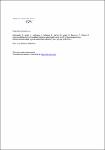Improved Detection of Mutated Human Cytomegalovirus UL97 by Pyrosequencing
Schindele, Birgit
Apelt, Luise
Hofmann, Jörg
Nitsche, Andreas
Michel, Detlef
Voigt, Sebastian
Mertens, Thomas
Ehlers, Bernhard
Ganciclovir (GCV) resistance frequently occurs upon prolonged treatment of ongoing active human cytomegalovirus (HCMV) infection in individuals with immature or compromised immune functions (e.g., recipients of solid-organ and hematopoietic stem cell transplants). Using pyrosequencing (PSQ), we established fast and sensitive detection of GCV resistance-associated mutations occurring in the HCMV open reading frame UL97. These mutations have been repeatedly associated with clinical treatment failure. We designed four PSQ assays and evaluated them by analyzing mixtures of plasmids or bacterial artificial chromosome-derived viruses containing UL97 wild-type and mutant sequences. A minimum level of 6% mutant sequence variants could be detected in these mixtures. In order to further evaluate the novel PSQ assays, we tested clinical specimens from patients with active HCMV infections. The results were compared with those obtained by conventional dideoxy chain terminator sequencing. As the PSQ method was more sensitive in detecting minor HCMV mutant fractions in a wild-type population, it is suggested that pyrosequencing is a useful tool for the early detection of emerging GCV-resistant HCMV in GCV-treated patients.
Dateien zu dieser Publikation
Keine Lizenzangabe

